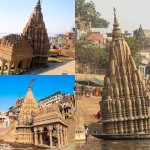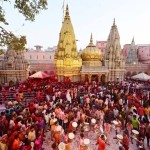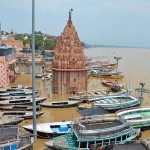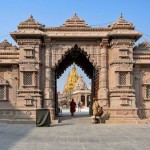Uncovering the Mysterious Kashi Karvat Temple Varanasi
Varanasi, also known as Kashi, is one of the oldest living cities in the world, holding an unparalleled place in Hindu spirituality. With its maze of narrow alleys, ghats along the sacred Ganges, and an array of ancient temples, Kashi has been a center of devotion, culture, and learning for millennia. Among its many sacred sites, the Kashi Karvat Temple stands out for its unique history, mysterious origins, and deep spiritual significance. Mentioned in ancient Puranas as a site of mukti (liberation), this temple attracts devotees and scholars alike, all drawn by the legends and lore that surround it.
Among its many sacred sites, the Kashi Karvat Temple stands out for its unique history, mysterious origins, and deep spiritual significance. Mentioned in ancient Puranas as a site of mukti (liberation), this temple attracts devotees and scholars alike, drawn by the legends and lore that surround it. Varanasi, also known as Kashi, is one of the oldest living cities in the world, holding an unparalleled place in Hindu spirituality. With its maze of narrow alleys, ghats along the sacred Ganges, and an array of ancient temples, Kashi has been a center of devotion, culture, and learning for millennia.
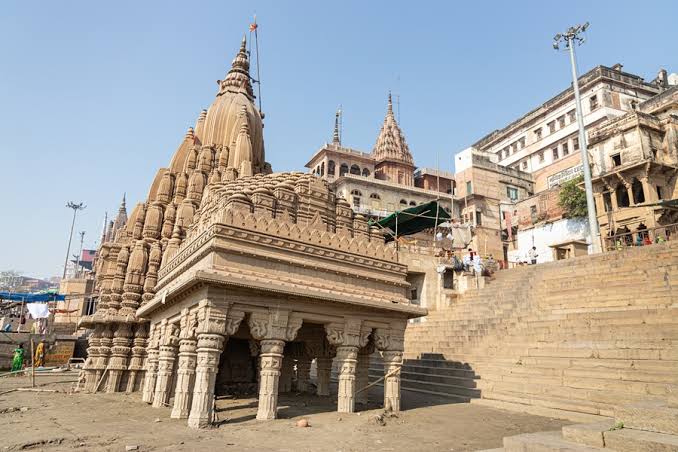
One example of Varanasi's continuing spiritual legacy is the Kashi Karvat Temple. The temple is said to have originated during the Dwapar Yug, one of the four periods of Hindu cosmology. The narrative describes a lowly woodcutter who showed such a great deal of devotion to Lord Shiva that he was bestowed with an immortal seat of worship. It is thought that this woodcutter is connected to the temple, where individuals would travel from all across India to present themselves as a sacrifice in order to receive moksha (salvation).
The word "Karvat" means "saw" in Hindi, an allusion that heightens the mysterious atmosphere around the temple. The thin line separating life and death, which is a major motif in the spiritual search for liberation, is represented by the saw. The name of the temple itself conjures a feeling of mystery, since its origins and intent are entwined with the fundamental Hindu concept of the cycle of life, death, and reincarnation.
Specimens of the Temple's Unique Architecture
The architecture of the Kashi Karvat Temple is among its most remarkable aspects. This shrine is constructed at such a low level that its garbhgriha (sanctum sanctorum) is submerged underwater for the majority of the year, in contrast to most temples that are tall and conspicuous. Considering that the temple was built centuries ago, its sanctum is situated 25 feet below the surface, making its construction an engineering marvel.
A noteworthy feature of the temple is its nine-degree tilt, which has led to it being dubbed "The Leaning Temple of Varanasi." Historians and architects have found the temple's low-lying construction and slope intriguing. The temple has endured the test of time and is still a site of devotion for devotees looking for spiritual comfort in spite of its slanting structure.
The Secret History of the Karvat Temple in Kashi Although myths and tales provide some light on the temple's genesis, the actual history of the Kashi Karvat Temple is still unknown. Based on historical documents, the temple was constructed about 500 years ago. One tale has it that the temple was built for Ratna Bai, the mother of Raja Man Singh, a well-known person in Indian history, by an unidentified servant.
Though not formally acknowledged as such, Bhima Shankar, the Shivlinga housed within the temple, is regarded as one of the twelve Jyotirlingas of Lord Shiva. This Shivlinga gives the temple an additional degree of sacredness and draws devotees who come to perform rituals and seek blessings.
The Kashi Karvat Temple's Spiritual Importance
The line separating the divine and the mundane has long been blurred at the Kashi Karvat Temple. The temple's spiritual significance is further enhanced by its placement on the banks of the Ganges. Hinduism regards the Ganges as the holiest river, and taking a bath in its waters is thought to atone for sins and lead to salvation.
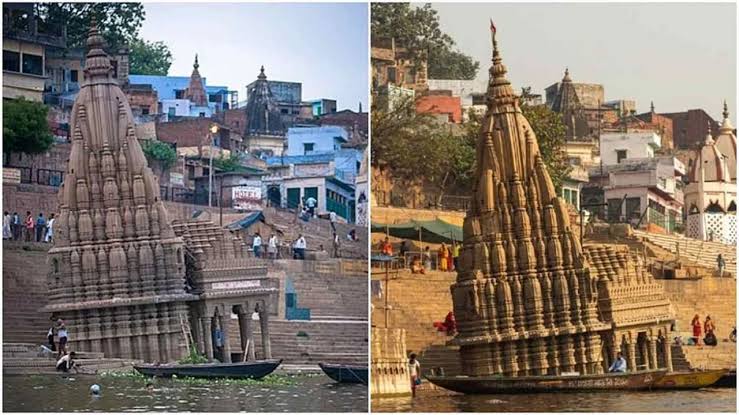
At the Kashi Karvat Temple, devotees frequently engage in rituals to honor their ancestors, ask for blessings for their family, and beg to be freed from the cycle of reincarnation. The temple is a potent location for people looking to transcend the physical world and become one with the divine because of its connection to mukti.
Celebrations and Rituals
At Kashi Karvat Temple, the customs are deeply ingrained and carried out with utmost devotion. The Karvat Pradakshina, in which devotees circle the temple in a certain fashion to represent the severing of earthly ties and the path towards spiritual freedom, is one of the most important ceremonies.
The garbhgriha is totally flooded during the monsoon season, when the Ganges is at its utmost flow, and prayer is performed from outside the temple. This immersion is regarded as a supernatural event that symbolizes the temple's close relationship with the river and the purifying properties of water. The temple is submerged in the Ganges, which, according to devotees, further sanctifies it and increases the efficacy of their prayers.
The temple experiences a surge of pilgrims during Lord Shiva's festivals and special events who come to partake in the aarti (a worship ritual with lit lamps) and abhisheka (ritual bathing of the god). The temple is filled with spiritual energy as a result of the ringing bells, the sound of Vedic chants, and the aroma of burning incense.
The Kashi Karvat Temple's Significance in the Local Culture
In addition to being a place of devotion, the Kashi Karvat Temple is an essential component of Varanasi's cultural landscape. It is a location where spirituality, mythology, and history all come together to provide an insight into the many rich traditions that have molded the city.
Local legends and folklore continue to keep the story of the Kashi Karvat Temple alive. It is said that those who die within the precincts of the temple are granted moksha and are freed from the cycle of rebirth. This belief draws many elderly and terminally ill individuals to the temple, hoping to spend their final days in its sacred surroundings.
The temple also plays a crucial role in the rituals associated with death in Varanasi. The city is known as the Mahashmashana (the Great Cremation Ground), and the Kashi Karvat Temple is one of the many sites where families perform the last rites of their loved ones. The temple's proximity to the Manikarnika Ghat, one of the most famous cremation ghats in Varanasi, further underscores its importance in the spiritual landscape of the city.
Preservation Efforts and Modern Challenges
Despite its historical and spiritual significance, the Kashi Karvat Temple faces several challenges in the modern era. The temple’s age-old structure requires constant maintenance to prevent further tilting and to preserve its unique architectural features. Additionally, the temple's low-lying location makes it vulnerable to flooding during the monsoon season, which poses a risk to the sanctum and the Shivlinga.
The Kashi Karvat Temple is being guarded and preserved by local officials and heritage conservationists. The temple's foundation is being strengthened, drainage systems are being improved to avoid waterlogging, and the temple's history is being preserved for future generations. Nonetheless, significant funding and continuous backing from the public and government are needed for these projects.
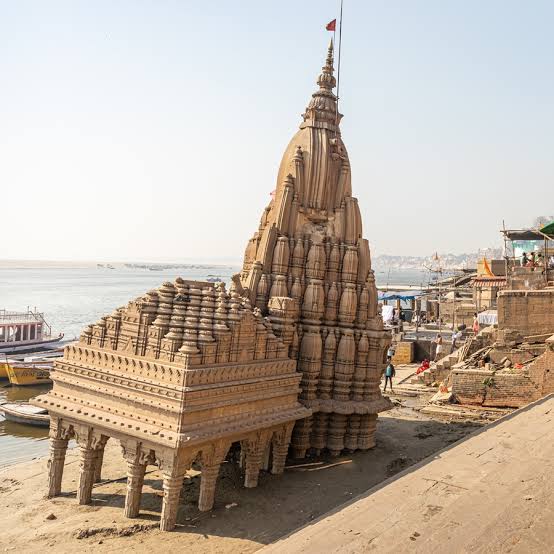
The temple must also strike a balance between adhering to its historic customs and modern expectations. Improved infrastructure and amenities are required to handle the increasing number of pilgrims that come to the temple each year. This involves making sure that the worship techniques and rituals are both accessible to a larger audience and stay faithful to their historical roots.
In summary
A hidden jewel in Varanasi's spiritual environment, the Kashi Karvat Temple offers a special fusion of mystery, devotion, and history. Owing to its slanting construction, subterranean sanctuary, and strong ties to antiquated myths, this location holds great spiritual value. A trip into the heart of India's sacred heritage, a visit to the Kashi Karvat Temple is a unique experience for those seeking a deeper knowledge of Hindu spirituality and the ageless traditions of Kashi.
You can't help but feel wonder and reverence when you stand at the temple's entryway and look up at its old walls and the Ganges River's sacred waters flowing nearby. Not only is the Kashi Karvat Temple a house of worship, but it also represents the eternal connection between the divine and the mortal world, the strength of faith, and the pursuit of emancipation.







